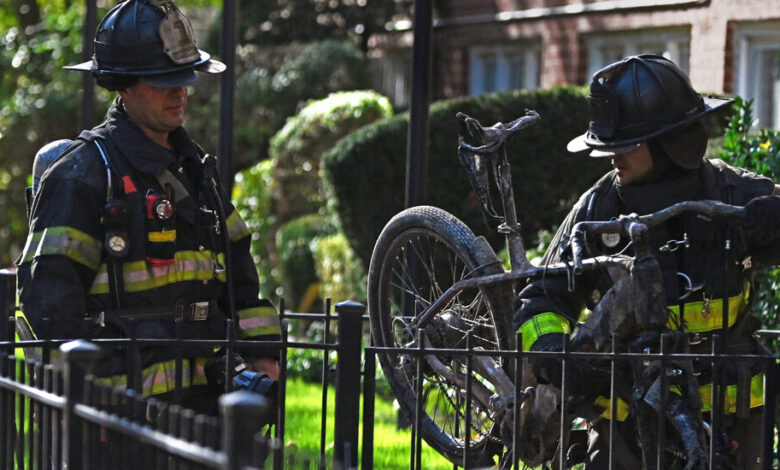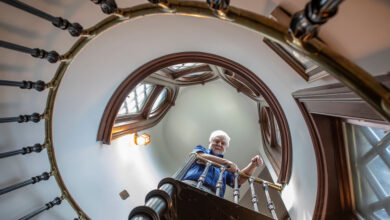E-Bikes Are Convenient. They Can Also Catch Fire and Destroy Buildings.

[ad_1]
Just before midnight on a Friday in January, a fire tore through a three-story house in East Elmhurst, Queens, injuring 10 people inside and killing a 63-year-old man who was trapped on the second floor. Five days later, on a rainy Wednesday afternoon, another fire broke out in the basement of a house in Forest Hills, Queens, where an unauthorized day care center was housed. Eighteen children were injured, one seriously.
The cause of both fires was rechargeable lithium-ion batteries, which power the e-bikes and e-scooters that have become ubiquitous on city streets, according to the New York Fire Department.
Jose Corona, whose e-scooter sparked the deadly fire in East Elmhurst, told reporters that he heard an explosion shortly after parking the scooter on the first floor of the house. “Once I opened the door, on the second floor the stairs was already on fire in seconds,” he said.
The use of micro-mobility vehicles surged during the pandemic as New Yorkers shunned public transportation and ordered food from delivery apps rather than crowd into restaurants. Delivery workers are increasingly reliant on e-bikes, which allow them to go farther and faster to meet the demand.
But a deadly, unintended consequence has emerged: Storing and charging such bikes and scooters indoors can create a tinderbox. Last year, the batteries caused 216 fires, with 147 injuries and six deaths. As of Feb. 27 this year, they were responsible for 30 fires, 40 injuries and two deaths, according to the Fire Department.
Nearly three years after New York City legalized the use of micro-mobility vehicles, building managers and lawmakers are grappling with how to prevent battery fires, with some calling for prohibitions on e-bikes and e-scooters, at least until ways to minimize the risks have been established.
Last week, the City Council took what it called “a first step in mitigating the fire risk posed by lithium-ion batteries,” approving a spate of bills that would include new safety and certification standards, education campaigns on how to prevent fires, and restrictions on the use and sale of used or reassembled batteries.
That, experts say, is where much of the danger lies — from off-market, refurbished, damaged or improperly charged batteries. A chemical reaction inside the self-fueling battery can spark a “thermal runaway,” which occurs when the lithium-ion cell enters a volatile, self-heating state. The fires are also difficult to extinguish (the Fire Department warns against using fire extinguishers or water), often spreading to nearby batteries, and can even reignite hours later.
“All it takes is for one small battery cell to be defective, overcharged or damaged, and a tremendous amount of energy is released in the form of heat and toxic flammable gases all at once,” said Daniel Murray, the Fire Department’s chief of hazmat operations.
The Fire Department started tracking fires caused by lithium-ion batteries in 2019, “when we recognized we had a problem,” Mr. Murray said. That year, the department recorded 28 fires resulting in 16 injuries — a number that has skyrocketed with the proliferation of the bikes and scooters.
Lithium-ion batteries can be found in computers, cellphones and some household devices, but micro-mobility vehicle batteries are bigger and “are subject to a lot of wear and tear and weather, which tends to damage them,” Mr. Murray said. “So that’s why we are seeing a lot of fires specifically in the bikes and scooters.”
Battery fires have broken out in a range of buildings around New York, from public housing complexes to luxury towers.
“I didn’t even know I was supposed to be afraid of the e-bike battery-charging station on the ground floor,” said Gail Ingram, who until last June lived above a pedicab and bike-rental business in a Hell’s Kitchen walk-up. One morning, she “heard a woman screaming” outside. Then she saw smoke rising from the floorboards.
The stairwell was quickly consumed by smoke that scorched her eyeballs. “I’ve never felt such a terrifying feeling, not being able to breathe,” said Ms. Ingram, 51, a nurse practitioner.
No one was seriously injured, though Ms. Ingram lost almost everything. Unlike most of her neighbors, she had renter’s insurance, which is now paying for her to live in a tiny hotel room with her two cats. “I’m still going through boxes of non-salvageable keepsakes and water-soaked paperwork,” she said.
Ms. Ingram’s upstairs neighbor, Madison Coller, 26, who works in risk management for a payment-processing company, was on the third floor when the fire broke out. She recalled a harrowing day, awakening from a nap and fleeing after she smelled smoke and heard a voice yelling, “Fire!” Displaced by the fire and having no insurance, she stayed with her brother in Bushwick and moved back to Rochester for a short while. Battery-powered vehicles “should be banned until there is a safer solution in place, because too many people have lost their lives,” said Ms. Coller, who now lives in Bushwick.
Some buildings have already taken that action. Last November, dozens of people were injured in a luxury high-rise rental building on East 52nd Street when a battery exploded in an apartment doubling as an unauthorized bike-repair shop. The incident spurred Glenwood Management, which operates more than two dozen luxury rental buildings in the city (though not that one), to ban e-bikes and e-scooters in all its buildings. “If you have one,” the company wrote in a notice to tenants, “we ask that you remove it at once from your apartment.”
A few months earlier, the New York City Housing Authority had proposed a ban on storing and charging e-vehicles in all 335 of its building developments, to prevent fires and preserve the health and safety of residents.” After an outcry by residents opposing the ban, the agency decided to pause and revisit the issue.
“Some buildings are taking the approach of a complete ban on e-bikes, and other buildings aren’t doing anything, and then there are those buildings in the middle that are trying to regulate and pass rules that kind of split the baby,” said Leni Morrison Cummings, a lawyer at the firm of Cozen O’Connor, who represents condominium and co-op boards. “At first we saw all the buildings that jumped on the bandwagon with the ban. Now I am seeing buildings trying compromise positions.”
Proposals include requiring residents to register their e-bikes. Others call for fire-safe bike rooms in apartment buildings and more education about battery safety.
“It’s a conversation buildings need to have: How do we limit the risk?” said Eric Wohl, a lawyer representing condo and co-op boards at the firm Armstrong Teasdale. “Unit owners are allowed to have candles, and that’s a fire risk, too.”
Drake Chan initially used a kick scooter to commute from his condo on the Upper East Side, cutting his long walk to and from the subway. He bought an e-scooter last year.
“You get places faster, and it saved me in terms of sweating it out during the summer,” said Mr. Chan, 37, who works as a project engineer in the field of transportation. “It can also carry quite a bit. I can put two bags of groceries on each handlebar.”
So when his condo board recently considered banning e-bikes and e-scooters in his building, he persuaded the board members to reconsider, emphasizing that most lithium-ion fires are caused by low-quality or misused batteries. “I encouraged them to look into registering all e-bikes and e-scooters, so we know what we have on our hands,” Mr. Chan said.
He also urged the board to educate residents on safe battery use, including charging the batteries only while attended (never overnight), keeping flammable materials away, and using the manufacturer’s original cords and chargers.
Another potential solution is safer bike rooms. Ariel Aufgang, a New York-based architect and the principal at Aufgang Architects, has designed one using cinder blocks, upgraded electrical outlets and additional sprinkler heads. “Government moves too slowly,” he said. “These safety measures are a no-brainer.”
But some building managers question why the burden of safeguarding against battery fires should fall on them. “To me, the issue is product safety,” said Michael Rothschild, the president of the residential management firm AJ Clarke.
Someone shopping for a bike or battery “isn’t going to know if the battery is poorly made,” he said. “There should be an oversight agency to make sure what’s being sold is safe. That’s the way we handle most things.”
Last month, Laura Kavanagh, New York’s fire commissioner, sent a letter to the U.S. Consumer Product Safety Commission, saying the department was “on the front lines of this fight against deadly fires involving batteries in e-micromobility devices,” and urging the government to promote more safety regulations, including seizing imported batteries that fall short of industry standards, penalizing manufacturers who fail to inform authorities about product hazards, and recalling unsafe devices. She also recommended a ban on sales of “universal” battery chargers.
City lawmakers are just beginning to catch up. As part of the legislative package the City Council approved last week, Gale Brewer, a council member who represents the Upper West Side, has sponsored a bill that would require the fire department, in consultation with the Department of Consumer and Worker Protection, to develop an information campaign about the fire risks. Ms. Brewer proposed a bill in November that would “ban the sale of second-use batteries, those which are reconditioned or manipulated and sold on the secondary market,” according to her office.
“Older residents call me all the time. ‘There’s a bike in my building.’ They are very nervous,” Ms. Brewer said. “We have to do something about this issue because more people will die.”
Oswald Feliz, a council member who represents some neighborhoods in Bronx, has also introduced a bill that would impose “recognized safety standard certification” and require an micro-mobility vehicle to be certified in order to be sold in New York City. Another member of the council, Robert F. Holden of Queens, recently introduced a bill that would temporarily ban certain e-bikes and e-scooters throughout New York City.
“Right now, these batteries are killing people, and that’s why we have to do something drastic, or it’s going to continue,” Mr. Holden said. “I don’t want to not allow them forever. It’s only a pause until we get back to the drawing board and get the proper safeguards on them.”
Some of the proposed legislation focuses on the thousands of delivery workers who have come to rely on e-bikes to make a living. One bill would require the consumer and worker protection agency to distribute educational materials on e-bike safety for delivery workers in their language.
“I worry about the delivery people,” Ms. Brewer said. “They need support. They go through a lot of batteries because they are working on the street.”
New lithium-ion bike batteries typically cost at least $300 (and often much more), forcing many riders to turn to lower-quality products. “There is definitely a market where people don’t want to spend that,” said Mr. Wohl of Armstrong Teasdale. “Delivery guys don’t have a lot of money and they want to go as fast as they can because the more trips, the more tips.”
Los Deliveristas Unidos, a guild representing 65,000 app-based food delivery workers, is pressing the city to boost the e-bike infrastructure to include charging and parking stations, along with bathrooms, something that Mayor Eric Adams and Senator Chuck Schumer have pledged to do.
Ligia Guallpa, director of the Worker’s Justice Project, which oversees Los Deliveristas Unidos, said that e-bikes are invaluable in low-income communities that lack accessible transportation, and that without sufficient charging stations, many have no better option than to charge their e-bikes at home.
“Banning e-bikes from buildings without offering an alternative is not the right solution,” she said. “Low-income New Yorkers don’t ride a bike as a fun activity. These e-bikes are legal and people are using them as a way of survival.”
[ad_2]
Source link






